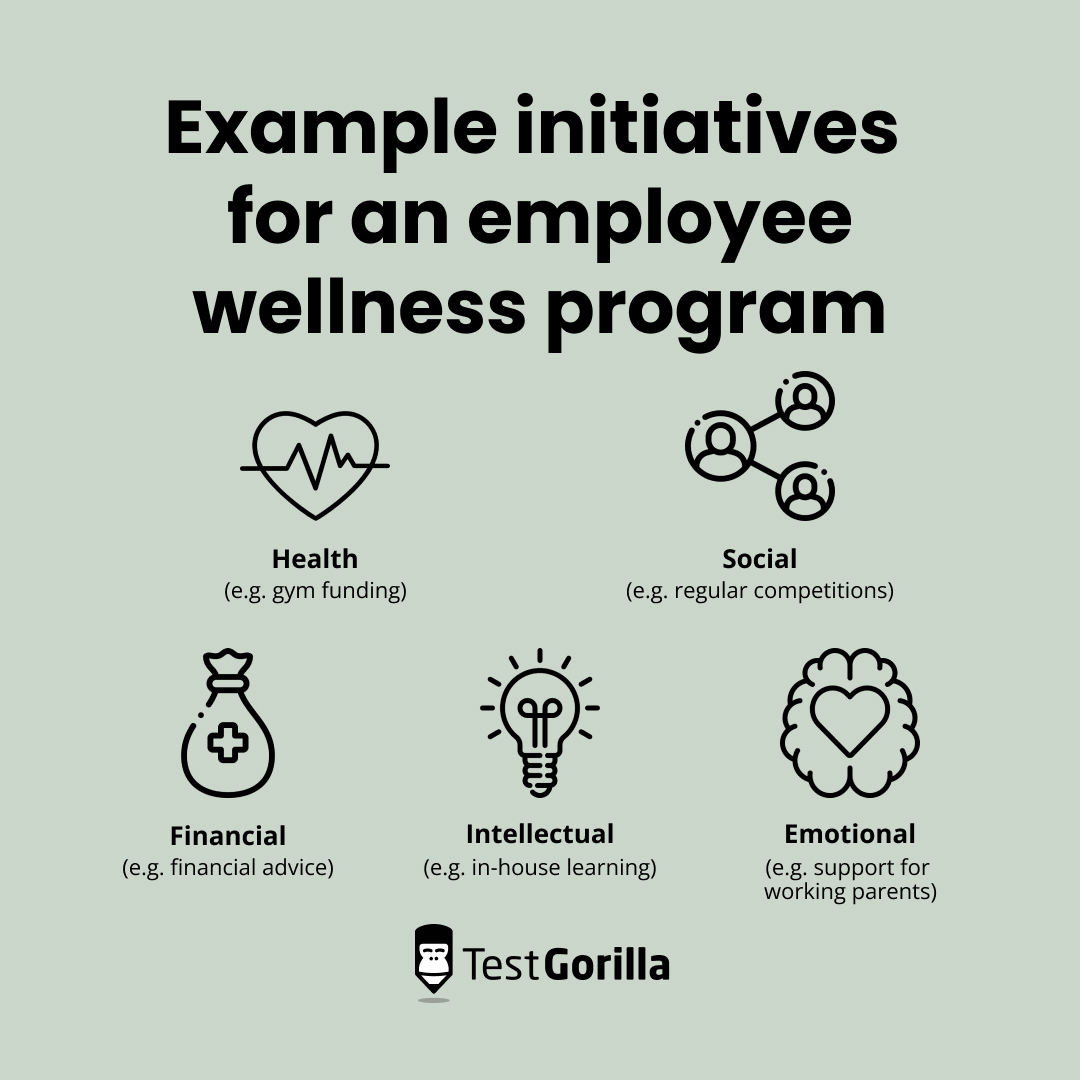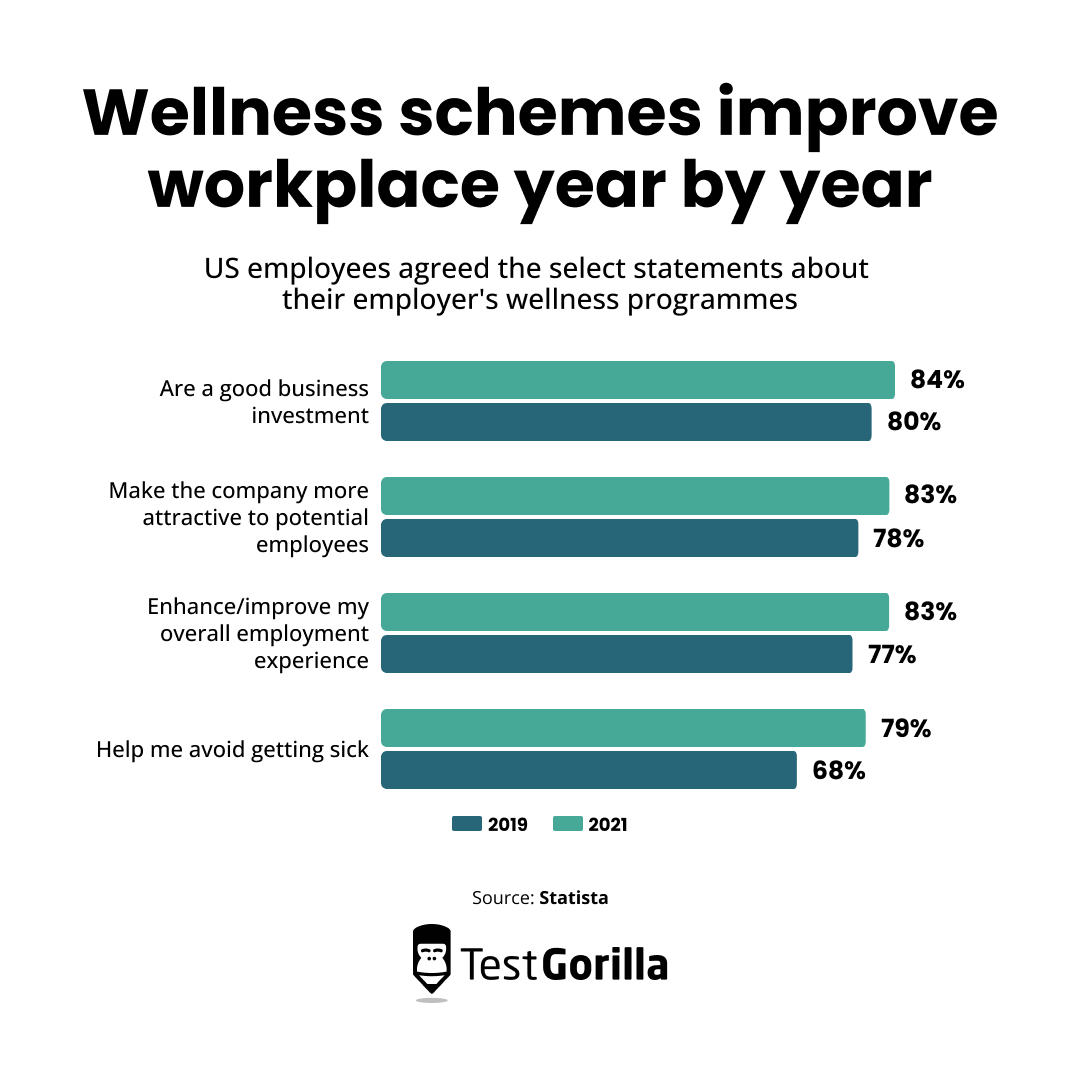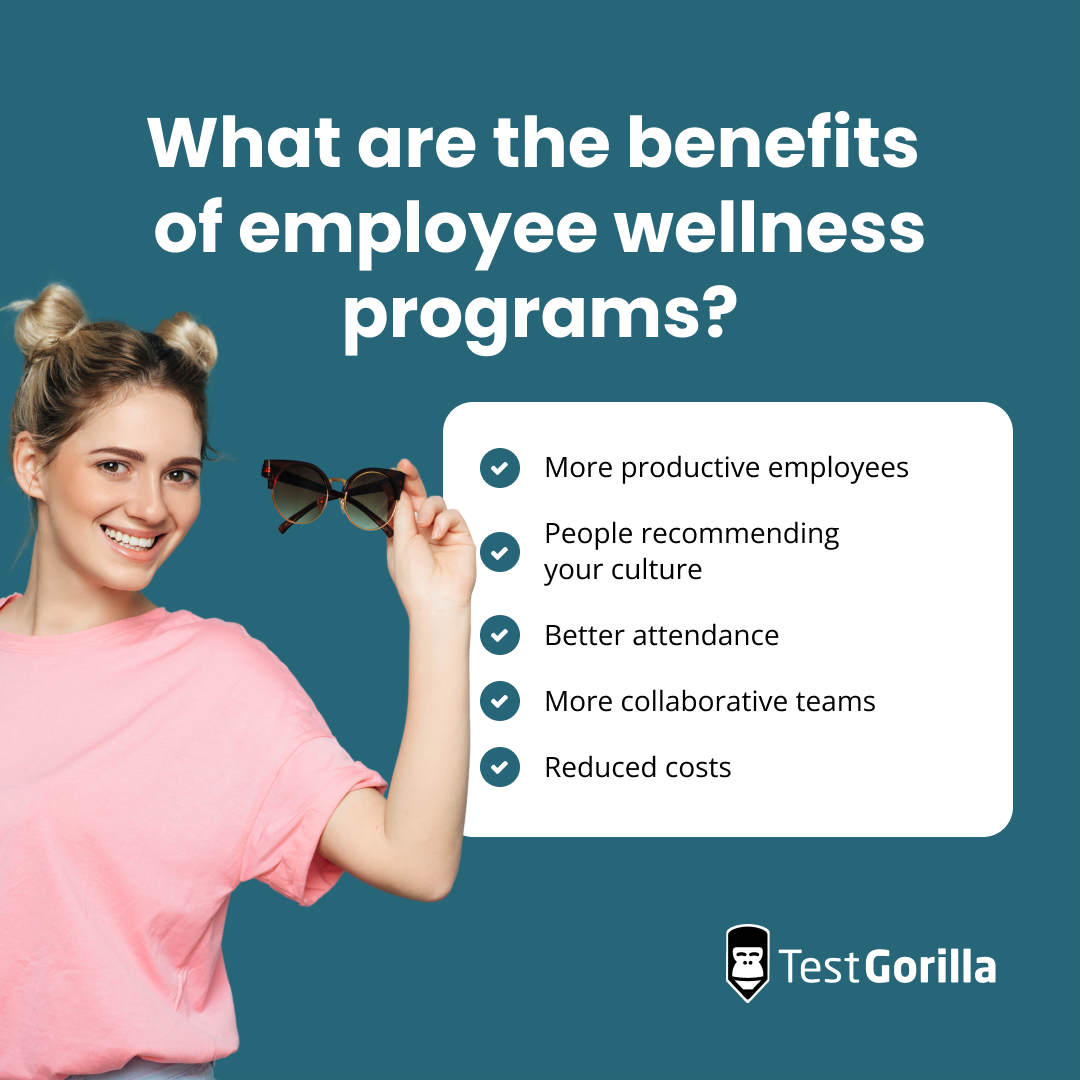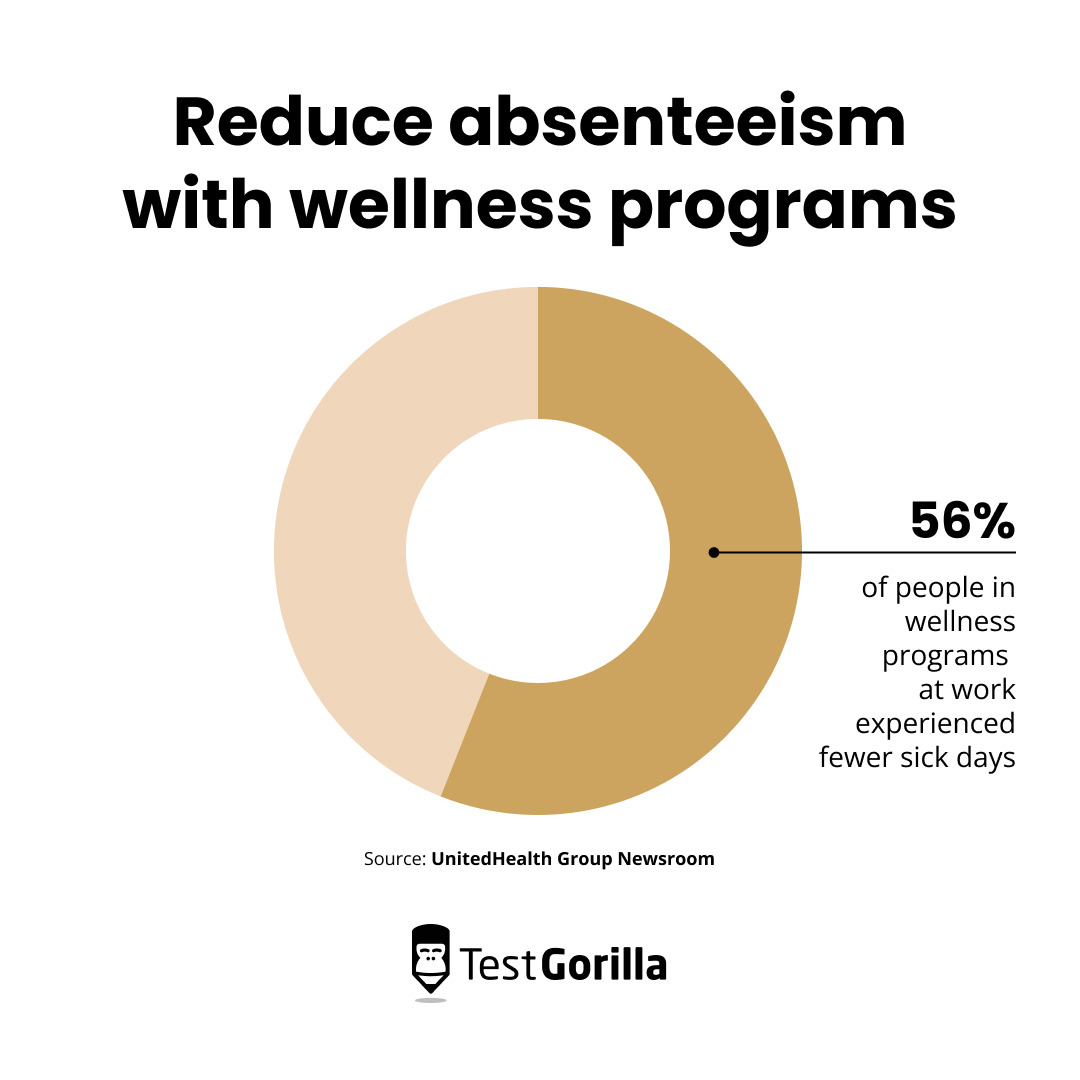Employee wellness: How to leverage this talent acquisition trend, attract the best, and take care of your people
You want healthy employees who stay happy, engaged, and productive – yet workplace stress and burnout continue to rise.
Around three in five people say they notice stress negatively impacting their work.[1]
Employee wellness is complex. You can’t fix all your staff’s problems with healthcare benefits alone.
However, if you offer blanket benefits, and your employees are still off sick and leaving in droves, it's time to rethink your strategy.
Wellness is a major driver of employee motivation. More than 60% of people value wellbeing support and work-life balance as the second most important factor when job hunting.[2]
Focus on wellness in the workplace as a talent acquisition trend and:
Kick-start your employer branding
Create a positive company culture
Expand your talent pool
Read on to learn how to build a wellness culture to improve employee experience and talent acquisition with wellness activities and health coaching.
Table of contents
- What is employee wellness?
- Why are employee wellness programs important?
- What are the benefits of employee wellness programs?
- 8 best practices for leveraging employee wellness to acquire top talent
- Employee wellness: 3 examples of companies succeeding with this talent acquisition trend
- Employee wellness is the key to workplace happiness
What is employee wellness?
Employee wellness is a blanket term for schemes and programs that support workplace health, covering your staff’s mental and physical wellbeing.
HR professionals use wellness initiatives to monitor employee morale, measure productivity, and ensure staff engagement.
It’s a powerful part of your overall talent acquisition strategy because it shows how much you care for your employees – something candidates look out for before they apply or accept a job offer.
What are the different types of wellness?
Here are some examples of employee wellness and how they can affect people's work.
Wellness type | What does it cover? |
Physical | - Are employees physically able to work? - Are they in pain, have limited mobility, or suffer long-term illness? |
Mental | - Do employees suffer from stress and anxiety? - Do they feel burned out and unable to perform at their best? |
Emotional | - Can employees manage their emotions? - Do they struggle to keep productive because of intense emotions or trauma? |
Social | - Do employees have positive social interactions? - Are there any workers who feel isolated? |
Intellectual | - Are employees intellectually stimulated by what they do? - Do they produce poor-quality work or get frustrated easily? |
Financial | - Do employees’ financial situations prevent them from completing work and meeting deadlines? - Do financial difficulties affect their mental state and morale? |
You’re not responsible for solving all your employees’ problems, like asking them to monitor their blood pressure, eating healthy food, or eliminating their health risks.
However, employee wellness programs help promote a healthy lifestyle and keep your team engaged.
What is an employee wellness program?
An employee wellness program is a series of ideas companies use to help improve staff wellbeing.
These programs have no fixed shape, meaning they depend on the needs of your employees and future hires.
Here are a few employee wellness ideas companies create for their staff:
Health initiatives
Health education and coaching
Gym funding and wellness reimbursements
Free bicycle rentals
Social initiatives
Regular events and competitions
Games rooms and libraries
Work socials
Financial initiatives
Travel subsidies
Financial advice and planning
Intellectual initiatives
In-house learning and development
Education subsidies
Volunteering opportunities
Emotional support initiatives
Support for working parents (such as childcare onsite)
Hands-off projects (to boost staff autonomy)
Remote employee opportunities
A typical employee health plan could include any of the above or focus on one or two elements.
Supporting employee health and wellness is important to ensure your people are the best they can be.
Why are employee wellness programs important?
Society’s interest in wellness and self-care is growing, and workplace wellness programs reflect this.
Records show that 83% of companies with 200 or more workers offer health-related programs, and 58% of smaller companies follow suit.[3]
Dive deeper into the data with our guide to the latest workplace wellness statistics.
Let’s examine why wellness programs are important for employers and their staff.
Importance for employers
Companies that support employee health and wellness attract more high-quality talent.
Studies in Canada suggest that 77% of employees prioritize better wellness support over higher pay.
It’s a significant boost for your employee value proposition.
Wellness schemes help reduce sickness and boost productivity, increasing in volume year by year.
For employers, that's money saved and output quality boosted. Supporting employee mental health at work is ethically right and reduces employee turnover.
Wellness-focused employers have a potential recruitment edge over their competitors. They stand to recruit more talent from a wider pool and appeal to hires who value wellbeing over other job perks.
An employee wellness program improves staff performance if mental or physical pressures are distracting or overwhelming. Firms that follow wellness schemes help keep teams on target by reducing any burden of mental stress and physical fatigue.
Importance for employees
Employees in wellbeing programs feel better supported by their workplaces. They feel more engaged with their managers and the company at large.
Wellness programs can instill a greater sense of value in employees besides encouraging healthy behaviors.
Wellness programs help prevent staff quiet quitting or leaving roles altogether because of stress or burnout.
The best insights on HR and recruitment, delivered to your inbox.
Biweekly updates. No spam. Unsubscribe any time.
What are the benefits of employee wellness programs?
Let’s consider some of the more tangible employee wellness benefits. These include:
More productive employees
People recommending your culture
Better attendance
More collaborative teams
Reduced costs
Before we explore how you can use workplace employee wellness to attract more talent into your firm, let’s break down these points in more detail.
More productive employees
Research shows most business leaders believe employee health and wellness affect productivity and performance more than morale, engagement, and safety.[4]
Studies further prove that morale and productivity go hand in hand.[5]
People are more likely to show loyalty and feel energized to work if they’re mentally stable, healthy, and part of a good company culture.
Workplace wellness statistics generally point toward happier, healthier people who are less stressed and are more likely to give you their all.
People recommending your culture
Nobody wants to work in a toxic culture where they must "suck up" their problems and keep going.
People are more likely to recommend a working environment that’s supportive and genuinely engaged with them. They don’t want to work for a firm that only sees them as numbers on a screen.
Building an employee referral program maximizes word-of-mouth promotion. Through these programs, staff recommend company benefits, culture perks, and wellness principles.
The business, meanwhile, reduces time-to-hire and reaches fresh talent across staff networks.
The bottom line is that good culture shines through as part of your employer branding and your reputation in your industry.
Better attendance
Employee absenteeism is a major worry for recruiters, particularly because of illness.
Between 1.4% and 5.3% of American full-time workers are absent owing to sickness, chronic disease, or health-related problems every month.[6]
Employee wellness programs help reduce legitimate cases of illness absenteeism.
Research shows that 56% of people in wellness programs at work experienced fewer sick days.[7]
With healthcare benefits, advice, and stipends, employers can expect workers to get healthier, be happier, and take less time off work. Even moving workers to remote projects could reduce absenteeism.
Employee burnout typically requires more than an occasional day off sick to recover from. Without employee wellness schemes, companies are at risk of losing mass productivity.
More collaborative teams
Wellness initiatives, such as work socials and team-building events, can help to boost collaborative work.
Group walks or hikes, quizzes, sports events, and volunteering can help boost morale and help people get to know each other better.
Looking for team-player qualities in new hires and encouraging collaborative skills in workers helps produce a more agile workforce, making talent mapping more efficient.
People who work collaboratively are 64% more productive and focused, feeling less tired than non-team players.[8]
Reduced costs
Traditional healthcare benefits in the US are not getting any cheaper, and inflation is hammering healthcare cost projections by hundreds of billions.
Companies also risk spending more on "cure" services than preventative measures.
Employee wellness programs offer preventive measures as incentives for employees.
These initiatives can stave off costly sick days, reduce human error, boost quality output, and reduce recruitment overheads.
Wellness requires careful budgeting. However, consider the cost compared with loss of revenue through:
Employee sickness
Poor-quality work
Revolving door turnover
Negative customer feedback
In many cases, wellness programs drive money back into a business.
The hard return on an employee wellness program always varies, although studies suggest a potential return of $1.50 for every dollar a company invests.[9]
8 best practices for leveraging employee wellness to acquire top talent
Here are eight proven ways to use an employee wellness program to attract the best candidates for your various roles and responsibilities.
How to use wellness strategy to boost your talent pool
Practice | Summary |
1. Offer workplace flexibility as a standard | Provide all staff with flexible scheduling opportunities from onboarding |
2. Support working parents as a priority | Create parent-focused wellness benefits such as competitive leave and childcare stipends to support marginalized candidates |
3. Match candidates to roles with skills-based hiring | Test people with skills tests for specific roles to ensure you match the most confident and motivated staff |
4. Promote wellness at the heart of your value proposition | Create a wellness-driven culture of development and healthcare support to appeal to candidates at risk of burnout |
5. Ensure your programs align with your culture | Back up your onboarding promises by providing access to perks and opportunities shortly after hiring and boost your reputation and appeal |
6. Diversify your wellness perks | Covering different employee wellness types broadens your recruitment scope and talent pool |
7. Create an external wellness resource | Set up wellness webinars, podcast episodes, knowledge bases, and apps to capture passive talent and show you’re a genuinely supportive company |
8. Lead by example | Put employee needs first and prioritize innovative ways to support their health; remove the harmful stigma against employee wellness |
1. Offer workplace flexibility as a standard
Up to 87% of employees would choose to work flexibly if the opportunity arose, so capitalize on this trend.
Flexibility in the workplace takes on many shapes, for example:
Four-day work weeks
Unlimited paid time off
Employees can:
Manage private concerns
Explore side projects
Unwind and recover from burnout
Flexible working enables human resources to work within your boundaries when they are most productive, boosts output quality for the company, and delivers a reliable return on investment from your hires.
Around 62% of people look for flexible working locations, yet only 40% of companies offer them.[10]
By offering flexibility as a key part of your value proposition to new hires, you appeal to the majority of talent and emerge as a leader.
2. Support working parents as a priority
Research suggests that in 59.8% of US married households with children, both parents work.
They need to find frequent childcare support around busy working schedules.
Some research suggests parental leave benefits are declining across the US. Around 35% of companies offer paid maternity leave, with 27% providing paid paternity leave.[11]
You need to show you support working parents.
By making parental support the heart of your employee wellness program, you stand to attract almost two-thirds of families who don’t receive perks such as leave or childcare support in their current roles.
It’s a reliable way to help attract diverse candidates. You expand your talent pool and find hidden talent other companies marginalize.
3. Match candidates to roles with skills-based hiring
Ensure employees are motivated and feel engaged by carefully assigning them to roles they're suited to.
Consider adopting a skills-based hiring system and talent assessment test culture to match your hires to specific positions.
Skills-based hiring and employee wellbeing are closely linked.
When you ensure employees match roles through skills testing, your team feels confident, capable, autonomous, and in control of their work.
Studies show that worker autonomy boosts psychological wellbeing.
Skills-based hiring could become part of your wellness program, provided you advertise it clearly in your recruiter marketing and value proposition.
Consider using personality tests to judge whether or not hires have the drive and potential to thrive in high-intensity roles.
Test for specific technical and power skills and eliminate your need for resume screening and guesswork.
Relying on guesswork often leads to promising candidates becoming bad hires. They might feel stressed or burned out if they can't meet expectations. Matching skills to roles is in everyone's best interests.
4. Promote wellness at the heart of your value proposition
Given how popular wellness initiatives are, there are few risks, if any, in promoting them to new hires.
Failure to address wellness programs in your marketing cuts out people who:
Feel burned out
Dislike their current roles
Struggle to feel valued
Have no progression opportunities
When you pair it with a culture of learning and development, wellness shows candidates you genuinely care.
It’s important to back up this claim with the right culture.
5. Ensure your programs align with your culture
Once new hires join you, they likely want to start benefiting from your programs and perks. Ensure your wellness programs align with your culture and ethos, or risk appearing disingenuous.
Candidates and employees value honesty and clarity.
Share case studies online through social media recruiting to show how you support your team. Give your employees opportunities to speak up and share what they love about wellness through your company.
Think carefully about the types of wellness perks you include in your culture. If you're a laid-back brand, lean into games rooms, work socials, and fun events.
If you’re in the healthcare industry or value family, focus on preventative health advice, parental benefits, and medical stipends.
6. Diversify your wellness perks
Diversifying benefits ensures you appeal to as many wellness types as possible.
For example, consider gym subsidies, bike rentals, or onsite exercise for physical wellness.
For intellectual wellness, focus on skills testing to align talent to the best possible jobs for their interests and provide learning resources.
For social wellness, schedule regular fun events to bring teams together.
Promote your wellness diversity via your recruitment marketing. Show candidates how much emphasis you put on different types of wellness and how you go beyond basic compensation and benefits to ensure staff feel happy and healthy.
Diversifying wellness perks supports a more inclusive hiring policy because you appeal to specific worker needs. You’re not just setting up a catch-all healthcare plan for the sake of checking boxes.
7. Create an external wellness resource
As part of a strong social media hiring plan, consider establishing yourself as an external "expert" in wellness.
Create thought leadership articles discussing taboo topics about workplace wellness and employee concerns.
For example, you could discuss trends in workplace mental health, burnout absenteeism, or impostor syndrome, and explore how you help support affected staff.
Consider creating a resource that people can use even if they're not applying with you. For example:
A podcast discussing stress and workplace trauma
An app providing meditation exercises
Regular webinars giving insight into your programs
All the above help with passive recruitment. You show people not looking for work that joining you could be worth it in the future.
8. Lead by example
Some of the statistics we shared throughout this guide show the stigma surrounding mental health and general employee wellbeing is waning.
Many people’s expectations for wellbeing benefits and workplace flexibility are becoming a reality.
Younger generations are driving the change in expectations.
Focusing on employee wellness is an asset when hiring Gen Z workers.
So blaze a trail – employee wellness programs are becoming more commonplace, but in line with the tips suggested above, tailor a unique program that appeals to specific people and stands out from your competition.
You’re likely to see a healthy return on investment, provided you follow through with your promises and stick to onboarding best practices.
Employee wellness: 3 examples of companies succeeding with this talent acquisition trend
To help you get a better understanding of how to use employee wellness programs in real-life situations, let’s explore three companies implementing them to help their staff feel motivated, healthy, and ready to thrive.
3 of the best employee wellness programs to inspire you
Company | Summary |
Asana | Offers healthcare stipends, unlimited paid time off, and competitive parental benefits |
The Motley Fool | Focuses on exercise for body and mind to beat the “Foolish 15” |
Etsy | Promotes the human side of business with mental health support, parental benefits, and complete healthcare |
Asana
Asana, a collaborative software company, provides various employee wellness benefits to appeal to candidates.[12]
For example, it provides mental health advice, vision and dental stipends, and $100 fitness boosts that employees can use each month to visit gyms and take steps to improve their physical health.
The company further supports working parents with up to 16 weeks of leave and a gentle return-to-work program. It even aids would-be parents with adoption support.
Add in unlimited paid time off, health workshops, yoga, and nap rooms, and you have a brand that invests in people first with an employee value proposition that maintains employee engagement.
This wide range of benefits and a focus on family helps keep the firm's talent pool broad, its talent pipeline thriving, and its workforce loyal.
The Motley Fool
The Motley Fool, a leading financial investment advisor, is an award-winner in providing wellness support to its staff.
For example, it's claimed prizes such as Most Athletic Company in DC and was on the shortlist of Greater Washington's Healthier Employers.
The company first referred to employee’s weight gain as the “Foolish 15” because of the passive nature of their staff’s work, the lack of physical activity, and easy access to unhealthy foods.[13]
Noticing these worrying trends, it started to brainstorm a wellness program around four different wellness challenges:
Exercise
Health promotion
Brain health
Nutrition
The investment advisor provides gym discounts, free onsite exercise equipment, sports stipends, nutritional consulting, and subsidized healthy meals.
However, it continues to provide monthly Pizza Days to keep up morale.
Etsy
Etsy, an online creative marketplace, is a good example of a company setting up an employee wellness program that ties directly into its culture and ethos.
Its main focus is to "keep commerce human."
With this, its wellness scheme celebrates the value of humanity within the company.
The firm largely focuses on health benefits, balancing employee financial wellness alongside physical and mental perks.[14]
For example, the company offers:
Fully paid healthcare
Up to 26 weeks of parental leave
Free mental health therapy
Work-life balance stipends
Unlimited paid time off for sickness and mental health
Dependent healthcare support
The brand further leans into appealing to specific groups of candidates by offering a tailored caregiver support package.
This backup care service enables anyone working for the business while caring for others to receive guidance, help with career development, and subsidies.
Employee wellness is the key to workplace happiness
It’s only ethical that all companies have employee wellness goals – after all, without happy, productive staff, they’re going nowhere fast.
Employee wellness programs should form part of your talent acquisition strategy for many reasons.
Used effectively, a wellness initiative can:
Help boost your employer brand and reputation
Attract talented people who need extra support at work
Reduce costs in hiring and time-to-hire
Build an attractive brand that appeals to passive hires
Of course, promising wellness is just one part of an appealing candidate experience.
Before building a wellness scheme from scratch, read more on crafting the perfect corporate identity.
Introduce skills-based hiring into your strategy, too, and find close-fitting roles for candidates with our assessment library.
Sources
1. “The American workforce faces compounding pressure: APA’s 2021 Work and Well-being Survey results”. (2021). American Psychological Association. Retrieved August 26, 2023. https://www.apa.org/pubs/reports/work-well-being/compounding-pressure-2021
2. Wigert, Ben. (February 21, 2022). “The Top 6 Things Employees Want in Their Next Job”. Gallup Workplace. Retrieved August 24, 2023. https://www.gallup.com/workplace/389807/top-things-employees-next-job.aspx
3. “Percentage of U.S. firms offering select health-related programs as of 2021, by firm size”. (2021). Statista. Retrieved August 24, 2023. https://www.statista.com/statistics/186229/effectiveness-of-disease-management-programs-in-containing-costs/
4. Miller, Stephen. (February 25, 2015). “Employers See Wellness Link to Productivity, Performance”. Society for Human Resource Management. Retrieved August 24, 2023. https://www.shrm.org/resourcesandtools/hr-topics/benefits/pages/wellness-productivity-link-.aspx
5. Osho, Gbolahan; Ashe, Carolyn; Wickramatunge, Jennifer. (January 2006). “Correlation of Morale, Productivity and Profit in Organizations”. National Social Science Journal, Volume 26, Pages 108 - 115. Retrieved August 24, 2023. https://www.researchgate.net/publication/309494308_Correlation_of_Morale_Productivity_and_Profit_in_Organizations
6. “Percentage of full-time workers in the U.S. absent from work for health-related reasons from 2015-2022, by month”. (2023). Statista. Retrieved August 24, 2023. https://www.statista.com/statistics/1259414/health-related-workplace-absenteeism-full-time-us-workers/
7. “Study: Employees with Access to Wellness Programs Say They Are More Willing to Devote Time to Their Health Compared to People without Such Initiatives”. (May 22, 2018). UnitedHealth Group Newsroom. Retrieved August 24, 2023. https://www.unitedhealthgroup.com/newsroom/2018/0522-employee-wellness-survey.html
8. Carr, Priyanka B.; Walton, Gregory M. (July 2014). “Cues of working together fuel intrinsic motivation”. Journal of Experimental Social Psychology, Volume 53, Pages 169 - 184. Retrieved August 24, 2023. https://www.sciencedirect.com/science/article/abs/pii/S0022103114000420
9. “Do Workplace Wellness Programs Save Employers Money?”. Rand Corporation. Retrieved August 24, 2023. https://www.shrm.org/ResourcesAndTools/hr-topics/benefits/Documents/RAND_RB9744.pdf
10. “What the data say: Two thirds of employees want flexible work hours; less than half of companies offer them”. Stagwell Global. Retrieved August 24, 2023. https://www.stagwellglobal.com/what-the-data-say-two-thirds-of-employees-want-flexible-work-hours-less-than-half-of-companies-offer-them/
11. “SHRM Releases 2022 Employee Benefits Survey”. (June 12, 2022). Society for Human Resource Management. Retrieved August 24, 2023. https://www.shrm.org/about-shrm/press-room/press-releases/pages/shrm-releases-2022-employee-benefits-survey--healthcare-retirement-savings-and-leave-benefits-emerge-as-the-top-ranked-be.aspx
12. Kemp, Zoe. (August 18, 2022). “Healthcare trailblazers: How Asana makes the most of free wellness benefits”. Sana Benefits Blog: Small Business Tips. Retrieved August 24, 2023. https://www.sanabenefits.com/blog/healthcare-trailblazers-asana-free-wellness-benefits/
13. “The Motley Fool: Not Your Cookie Cutter Wellness Program”. (February 27, 2018). HES Online. Retrieved August 24, 2023. https://hesonline.com/2018/02/27/motley-fool-not-cookie-cutter-wellness-program/
14. “An Inside Look at Etsy's Leave and Benefits Program”. (February 8, 2023). The Mom Project: In Good Company. Retrieved August 24, 2023. https://blog.themomproject.com/etsy-benefits
You've scrolled this far
Why not try TestGorilla for free, and see what happens when you put skills first.


















